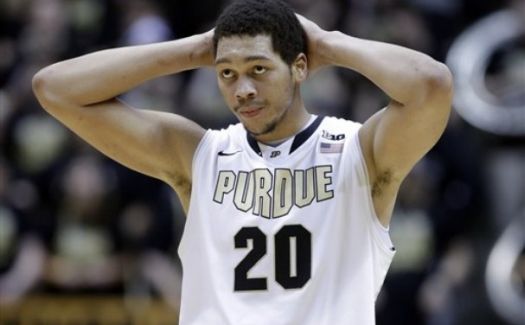On the Importance of Purdue’s Three-Point Shooting This Season
Posted by Jonathan Batuello on October 24th, 2013AJ Hammons has received plenty of talk regarding Purdue basketball coming into this season. It’s easy to understand why, because with a consistent effort and big year, the center could be headed for the NBA Draft next summer. His offensive production, though, isn’t as important for Matt Painter’s team as its ability to find some 3-point shooting. The Boilermakers will need to keep defenses from sagging down to protect the rim against Hammons, and right now, their outside shooting is a huge question mark.
Last season, Purdue was ninth in the Big Ten in 3-point shooting at 32 percent, and the team’s 3-point shooting leader, DJ Byrd, is gone due to graduation. Byrd made more than half of the Boilermakers’ treys last season, leaving the team with a bunch of mediocre-to-bad shooters beyond the arc. The heavy duty for returnees will fall to Terone Johnson, Ronnie Johnson and Raphael Davis, but all three of these players are better known for their ability to break defenses down off the dribble. Johnson was the best shooter among the group last season, but he still only made 37 threes on the year. Between the rest of the returnees outside of him, the group knocked down a combined 26 3-pointers. This means these players will not only need to improve their long-range shooting this year, but also be willing to look for it more often. This is not a good position for a team that will want to work the inside-outside game.
This puts a lot of pressure on incoming freshman Kendall Stephens and transfer Sterling Carter. If the returnees don’t improve from the outside at least to a point where teams must defend it, the pressure and minutes for these two could increase dramatically. Stephens, the son of former Purdue player Everette Stephens, has a 6’6” frame and high release and was a highly-rated prospect out of Illinois. He is known for his outside shot and if Purdue’s woes from distance reach a breaking point, don’t be surprised to see him potentially move into the starting lineup or at least get heavy minutes off the bench. Carter, on the other hand, shot 39 percent from three last season at Seattle. While the defense and competition in the WAC is quite a bit lower than the B1G, it’s still a better shooting touch than anyone on Purdue’s roster had all of last season.
The Boilermakers need these newcomers and the returnees to improve in this area, at least a touch above the team’s overall 32 percent from last season. When Purdue got its 3-point shooting percentage above the 38 percent mark in 2012-13, just below what Carter averaged, the team went 9-0. For a squad that finished the season at 16-18, that’s an incredible difference. If the Boilermakers can bring their percentage up to that mark and see the expected increased production from Hammons inside, it could be looking at a shot at the NCAA Tournament and potentially pushing the top teams in the B1G this season.










































